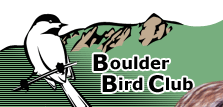Leaders' Field Trip Techniques
Your leadership on a birding field trip is very important. Here are some techniques which will help insure that your trip is a special one. Please read through these techniques before your trip and be properly prepared.
- Have a clipboard with sign-up sheet. *** Every
participant must sign the sign-up sheet due to liability concerns.*** Ask
non-members to give address, zip, and phone number so that we may send them
a complimentary copy of the newsletter & a membership slip. Welcome
each person as they sign the list. Name tags are very useful.
- Have a scope along. Having a scope on a trip is essential. Beginners will be able to have good looks at new birds and be able to see the field marks more clearly. It is also good to have a two way radio along if groups are large and have to split. They should be set to 11/22 the Birders Channel. Plug them in overnight before use to be fully powered.
- Orient the group:
IMPORTANT: Call the group together and introduce yourself as the leader and tell of your plans for the trip. Then if the group is not too large, have everyone introduce themselves. If you need help with any aspect of the trip, ask a participant to help you. Welcome new members and visitors.
- Ask if anyone needs assistance as a beginner or with binoculars. If necessary, take a moment to review how to focus binoculars properly.
- Ask that each person alert the leader and others in the group when a bird is seen. All birds are worth reporting and viewing - there is no such thing as a "trash bird."
- Ask participants to calmly describe the bird's location using landmarks or the "clock" technique. Explain if necessary.
- Review in general terms what birds are expected to be doing at this season, i. e. feeding, setting up territories, migrating, feeding young, etc.
- Explain that the leader should stay at the front of the group so that birds will not be flushed, else others might miss them. Keep the group together.
- Make sure everyone hears what you have to say. Talk loud enough to be heard and be in control.
- Demonstrate good field etiquette. Explain why to the group if needed
- Make certain that everyone gets a view of every bird, if possible. As each bird is found in the scopes ask folks to come up and take a look at the bird(s) in the scope. You might want to assign beginners to an accomplished birder to assist them.
- Keep watching after birds are identified. Watch for behaviors. Call these to the attention of the group. Ask them to respond when they see something. Remark about nesting birds or nests that you see.
- Report field marks that you see. Help others to see those marks. Call attention to songs that you hear and can identify. Give hints on how the song can be remembered.
- Provide information. Tell interesting details of behavior or of life histories of some of the species that you see, especially when birding is slow. Don't hesitate to inject other non-bird natural history topics pertaining to the area that you are in, such as geology, botany, other animals, or local history if you know it. It gives more depth to the whole trip.
- Vary your pace. When there are birds to watch, move slowly. When birds are scarce, quicken the pace. Just standing is very hard on most legs.
- Keep it fun. Regardless of how few birds you see, avoid the "how good the birding was here last week" syndrome. Reserve something for the end of the trip, such as showing a special nest, or a fine vista of the countryside. Be positive about this trip. End on time.
- At the end of the trip: Pull the group together for a brief review of the birds observed or number of species seen on the trip. Thanks are due all around. Invite people to come on the next field trip. Give date, time, and place.
Remember - the catalyst that really makes a birding trip fun is an enthusiastic and considerate leader - YOU!
THANK YOU ! Our Trip Leaders are really what makes the Club thrive and grow.
|




